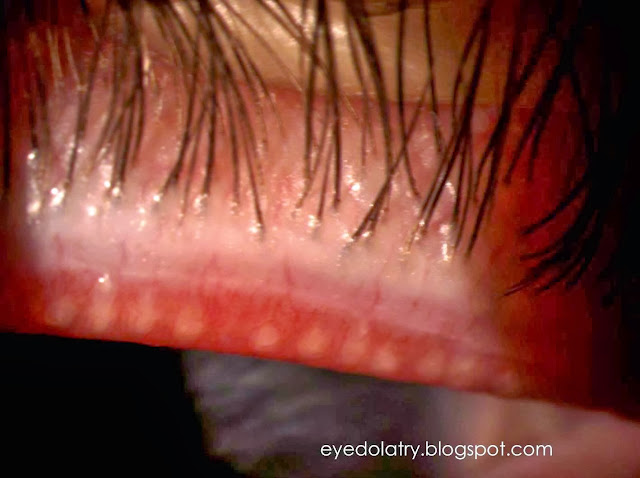In June 2023 a new drop got FDA approval for treating the signs and symptoms of dry eye disease: MIEBO (100% perfluorohexyloctane). Instead of targeting inflammation as a pathway to dry eye relief, MEIBO targets tear film evaporation. Studies show that excessive tear evaporation is the most common cause of dry eye disease, with 86% of patients with dry eye experiencing some form of meibomian gland dysfunction. The meibomian glands are oil glands located in our top and bottom eyelids, and every time we blink they release the topcoat oil layer of our tears. If the glands are clogged, damaged, or inflamed, the oil cannot be released properly onto the eye's surface and our tears very quickly evaporate away.
How Does MIEBO Work?
MIEBO works by targeting evaporation; it mimics the natural meibomian gland-released oil layer on the eye by spreading evenly across the eye's surface and reducing evaporation of the tear film. The drop gained FDA approval based on the outcomes of 2 multicenter, placebo-controlled studies: GOBI and MOJAVE. In these studies MIEBO showed statistically significant improvement in dry eye symptoms (measured by the Ocular Surface Disease Index [OSDI] and the Visual Analog Scale) and signs (measured by corneal staining - this is where dry and broken corneal cells are visualized using a sodium fluorescein dye). Full resolution of corneal staining was seen as early as day 15 using the MIEBO drop treatment!
MIEBO is
- preservative free
- water free (which greatly reduces the risk of microbial growth!)
- to be used 4 x a day for maximum efficacy
- should not be used with contact lenses; wait 30 minutes after using Miebo before inserting a contact lens
Side Effects
The side effects of MIEBO were very minimal in the Phase 3 clinical studies: 0.05% of patients reported pain with drop insertion, 2.1% of patients reported blurry vision with drop use, and 0.8% of patients reported redness with drop use. MIEBO has not been studied in patients who are pregnant or nursing, or for use in children under the age of 18.
Other Interesting Science
Perfluorohexyloctane (F6H8) as a molecule has been studied extensively in dry eye both in Europe and the US before the release of MIEBO as an FDA-approved treatment for dry eye, and this research has sparked plenty of buzz for eye doctors who have been highly anticipating a new approach to dry eye. Research on F6H8 shows it increases tear film thickness by 10 mm after insertion, reduces the friction between the eye and eyelids when you blink, and actually causes slight changes to the eye's surface temperature. Have you ever noticed how your eyes water in really cold air? We have cold thermoreceptor nerve cells on the eye's surface, and by activating these nerves you will increase the release of tears and increase the rate of blinking (which would thus also increase the rate of Meibomian gland oil release!). Within 5 minutes of F6H8 drop insertion, ocular surface temperature measured by infrared video imaging decreased by an average of -0.7 degrees Celsius. Saline drops had no impact on corneal temperature.
 |
| Infrared images showing the cooling effect of perfluorohexyloctane (F6H8) drops via. In Row A The right eye was given F6H8 drops and the left eye was given saline eye drops (which showed no temperature effect). In Row B, both eyes were given F6H8 drops. The cooling temperature effect was seen within 5 minutes of drop instillation and continued through 30 minutes after drop instillation. |
Another interesting discussion regards the category of MIEBO as a PFAS (per- and polyfluorinated substance), which has come under some scrutiny as the European Union has investigated changes and potential bans to how these chemicals are used in over the counter and prescription products. Check out this article for a deeper dive into PFAS and the possible risks. In a statement from Bausch and Lomb, MIEBO is by definition a PFAS molecule, but that definition does not "inform whether a compound is harmful or not." Perfluorohexyloctane (MIEBO) is "physically, chemically, and physiologically inert, and is practically immiscible in water." The molecule has also undergone "extensive genotoxicity, mutagenicity, and toxicology studies with no significant adverse effects." Perfluorohexyloctane has been used with a high safety profile for many years as an eye drop in other countries, and for intraocular injections in the treatment of retinal detachments without incident.
Because the drop is not water soluble, the risk of it being absorbed into the body is reported as minimal. Studies show the main route of elimination of perfluorohexylocatane is evaporation off the ocular surface.
As of writing this article, MIEBO drops are most readily available through the mail-order pharmacy, BlinkRx. Consult with your eye doctor to learn more!


No comments:
Post a Comment